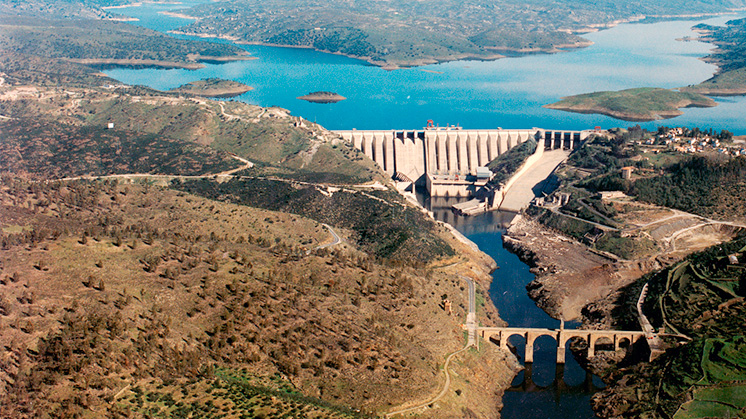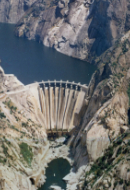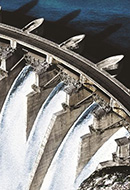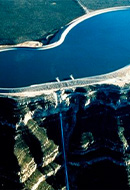José María de Oriol hydroelectric power plant (Alcántara I)
The José María de Oriol hydroelectric power plant, key to renewable production in Extremadura
Hydroelectric power Operating plants
The José María de Oriol power plant, with more than 50 years of history, is a hydroelectric facility located in the municipality of Alcántara, in Cáceres. With a total installed capacity of over 900 MW, the plant is one of the cornerstones of Iberdrola's renewable energy production in Extremadura, in southwest Spain.

José María de Oriol Hydroelectric Power Plant




The José María de Oriol hydroelectric plant, popularly known as the Alcántara plant due to its proximity to the municipality of the same name, is located on the course of the river Tajo as it passes through the province of Cáceres. This facility is one of the cornerstones of Iberdrola's renewable energy production in Extremadura, with an installed capacity of 957 MW, more than any of the company's other facilities in the region.
The Alcántara II reservoir was the largest of those built in Spain and the second largest in Europe until 1990, with its 3,162 cubic hectometres and a length of 91 kilometres. Its lightened gravity and double buttress dam, made up of 19 separate triangular-shaped elements, brings together the confluent waters of the Tagus, the Alagón and the Tiétar (the latter two are tributaries of the former).
The José María de Oriol dam has two spillways (hydraulic structures for the release of large flood flows) and two bottom spillways. The surface spillways have a combined capacity of 12,000 cubic metres per second and the bottom spillways have a total capacity of 600 cubic metres per second. The crest of the dam is 223 metres above sea level and is 7 metres wide and 570 metres long.
The hydroelectric power station, which has four generating sets, is located at the foot of the dam on the left bank, within the riverbed and adjacent to the central spillway basin.
History of the José María Oriol power station
In 1970, at the request of the Town Council, the dam was given the name of the then president of the company Hidroeléctrica Española (predecessor of Iberdrola), José María de Oriol.
For its location, among the technical qualities, reasons such as the location of the Alcántara bridge were taken into account. The technical experts were amazed at the skill of the Roman engineers in the construction of this jewel of the area, located some 800 metres from the José María de Oriol dam and considered to be the most perfect Roman work of its kind in Europe. In addition, the turbines were transported from France to Alcántara along a route traced by means of Roman bridges, including the Alcántara bridge.
It was not only a question of moving large pieces of infrastructure. The dimensions of the project required a large workforce, which was hired in Alcántara but also in the region and in many other parts of Spain. They were also joined by technicians from numerous countries , and it is estimated that at the peak of employment, 3,500 people were employed and a total of 5,000.
The municipality of Cáceres experienced an important growth that changed the life of the area. In just a few years the population increased considerably and demographic development was accompanied by economic development.
Iberdrola acquired the Convent of San Benito de Alcántara in 1961 in order to restore it and locate there the residence of the engineers working on the dam. The building is still owned by Iberdrola, which in 1985 established the San Benito de Alcántara Foundation in the building. The aim of the foundation is historical and cultural study and research, especially in connection with tourism and the social development of Extremadura. The foundation is also made up of the Order of Alcántara, the Town Council of the municipality, the Provincial Council of Cáceres and the Chambers of Commerce and Industry of Cáceres and Badajoz.
The salvage of the Alcantara bridge
The Alcántara bridge has been rehabilitated on numerous occasions. However, the foundations of the infrastructure were always left out of any inspection or treatment because the river, in low water, did not allow them to be appreciated.
The construction of the Alcántara dam had a practical side effect. It was now possible to leave the river bed dry in the vicinity of the bridge in order to analyse the foundations and act on them, if necessary.
In 1969, several studies with divers revealed certain problems at the base of the bridge, and the new possibility offered by the dam confirmed this. When the riverbed was allowed to dry up, a large sinkhole was observed in the foundation of the right pier, which always remains under water.
Although the piers are well founded on rock, the passage of the Tagus River over the course of its history had eroded one of its bases. It is difficult to guess what the future of the bridge would have been had it not been fully restored, but if there is one thing that is clear, it is that the construction of the Alcántara dam has contributed to preserving a great historical work.
Iberdrola, world leader in renewable energies
At Iberdrola, we dare committed to renewable energy more than two decades ago as a fundamental pillar on which to build our safe, clean and competitive business model. Thanks to this vision, we are today world leaders in renewables, reaching 44,478 MW of clean energy in operation at the end of 2024.
This commitment is reflected in our Strategic Plan, in which we will allocate €15.5bn gross to renewables. More than half of this amount is focused on offshore wind in the US, UK, France and Germany; 28% on onshore wind and 18% on solar.

What is hydroelectric energy
Find out how hydroelectric power plants work.

Types of dams
There are different types of dams depending on their materials or mechanisms.

Hydropower terms
The 10 most relevant concepts in hydropower.

Pumped-storage hydropower plants
Do you know what pumped-storage hydropower stations are used for?




